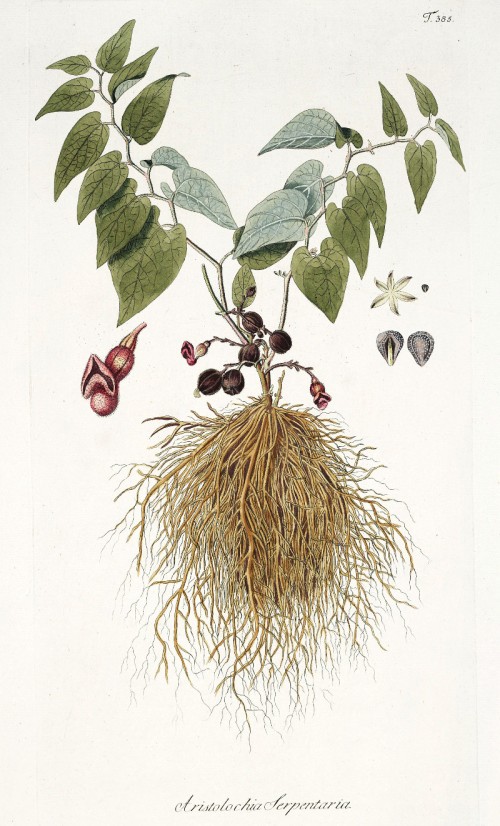Dies ist eine alte Version des Dokuments!
Aristolochia serpentaria L. - syn.Aristolochia convolvulacea Small; Aristolochia hastata Nutt.; Aristolochia nashii Kearney - Aristolochiaceae
Virginia snakeroot, Virginische Schlangenwurzel
Perennial herb with slender, wavy stem, up to 50cm high, native to the woods of eastern and southern North America; short rootstock with many thin fibrous roots; leaves thin, heart-shaped at the base and pointed at the apex, 4-8(-15)cm long, 3-4cm wide; leathery solitary brown flowers, about 1cm long, at the top of slender stems arising near the base; fruit a hard round capsule, 1cm long, with numerous seeds.
„ Inflorescences of Aristolochia serpentaria often bear closed flowers that appear to be cleistogamous. Leaf shape varies greatly between populations, especially with regard to leaf width and size of basal lobes. This variability is especially interesting because eastern pipe-vine swallowtail butterflies, Battus philenor philenor (Linnaeus), use leaf shape as a search image when looking for Aristolochia leaves on which to lay their eggs.
The dried rhizome, called Virginia snakeroot or serpentary, is a popular herbal tonic. In small doses, it is a gastric stimulant and diuretic. Large doses can cause violent gastric distress and respiratory paralysis (J. A. Duke 1985). The rhizome contains aristolochic acid and trimethyl amine, both potential carcinogens.
Several Native American tribes used Aristolochia serpentaria for diverse medicinal purposes, including treatment of rheumatism, various pains, obstructions, worms, toothaches, sore throats, fever, sore noses, and colds, as a tonic, and mixed with saliva for snake bites (D. E. Moerman 1986).
http://www.efloras.org/florataxon.aspx?flora_id=1&taxon_id=233500164
The golden-yellow rootstock (with roots) of Aristolochia serpentaria is called snakeroot, Serpentaria, (german Virginische Schlangenwurzel), Rhizoma serpentaria. The drug smells agreeable turpentine-camphorlike and tastes bitter-camphoraceous. It contains aristolochic acids and essential oil. During north american colonial times this drug was widely used not only to treat snakebites but also for its diaphoretic, tonic, carminative and diuretic properties. It has been used internally as anti-inflammatory agent to treat rheumatism and arthritis, externally for slow healing wounds. Because of the carcinogenic potential of aristolochic acid, it is now considered inadvisable to use this drug.

Jacquin,N.J. von, Plantarum rariorum horti caesarei Schoenbrunnensis descriptiones et icones, vol.3 t.385 (1798)
http://plantgenera.org/species.php?id_species=88533
